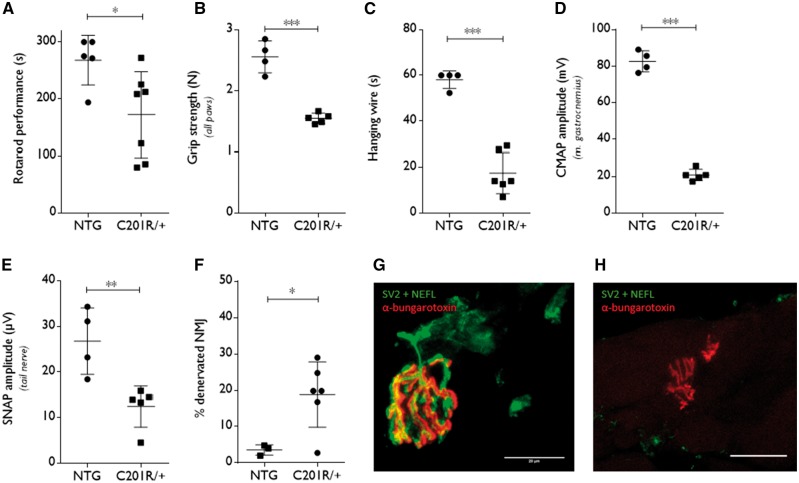Figure 3.
Motor and sensory deficits reminiscent of CMT2D are present in 1-year old GarsC201R/+ mice. (A) The motor performance of GarsC201R/+ mice and littermate controls (non-transgenic, NTG) was assessed by a rotarod test which accelerates from 4 to 40 rpm for 5 min: non-transgenic 268 ± 43.68 s, n = 5 mice versus GarsC201R/+ 172 ± 75.51 s, n = 7 mice; unpaired t-test t = 2.531, P = 0.0298. B. Grip strength was measured in all paws using a grid in combination with a dynamometer: non-transgenic 2.55 ± 0.26 N, n = 4 mice versus GarsC201R/+ 1.54 ± 0.08 N, n = 5 mice; unpaired t-test t = 8.211, P < 0.0001. (C) Mice were tested for the ability to hold on to a grid in the hanging wire test and the time spent hanging was measured with a maximum time limit of 60 s: non-transgenic 58.08 ± 3.84 s, n = 4 mice versus GarsC201R/+ 17.45 ± 8.96 s, n = 6 mice; unpaired t-test t = 8.436, P < 0.0001. (D) CMAP amplitudes were recorded in the gastrocnemius muscle: non-transgenic 82.68 ± 5.79 mV, n = 4 mice versus GarsC201R/+ 20.84 ± 3.14 mV, n = 5 mice; unpaired t-test t = 20.61, P < 0.0001. (E) SNAP amplitudes were measured in the tail nerve: non-transgenic 26.75 ± 7.263 µV, n = 4 mice versus GarsC201R/+ 12.42 ± 4.53 µV, n = 5 mice; unpaired t-test t = 3.645, P = 0.0082. (F) The innervation of neuromuscular junctions was evaluated by quantifying the percentage of neuromuscular junctions demonstrating overlap of neurofilament light, NEFL/synaptic vesicle glycoprotein 2A, SV2 and α-bungarotoxin staining: non-transgenic 3.57 ± 1.43%, n = 3 mice versus GarsC201R/+ 18.81 ± 8.98 %, n = 6 mice; unpaired t-test t = 2.826, P = 0.0255. (G and H) Innervated (G) and denervated (H) neuromuscular junctions (NMJs) in the gastrocnemius muscle were visualized by immunofluorescence (green: NEFL + SV2; red: α-bungarotoxin). Confocal images are represented. Scale bar = 20 µm. For colour blind corrected figure, see Supplementary Fig. 2F and G.

